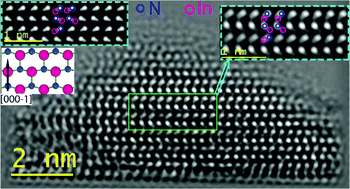Unravelling the polarity of InN quantum dots using a modified approach of negative-spherical-aberration imaging†
Abstract
InN quantum dots (QDs) are considered to be promising nanostructures for different device applications. For any hexagonal AB-stacking semiconductor system, polarity is an important feature which affects the electronic properties. Therefore, the determination of this characteristic on any wurtzite (semi)polar III–N compound or alloy is essential for defining its applicability. In this paper, the polarity of InN QDs grown on silicon by indium droplet epitaxy plus nitridation and annealing was determined by a modified approach combining exit wave reconstruction with negative-spherical-aberration high-resolution lattice imaging using TEM. Comparing the micrographs of two QDs from the same TEM specimen with the simulated images of InN slab structures generated under the same conditions as of the experiments, it was confirmed that the QDs of the present study are N polar. Given that the settlement of material's polarity has always been a tedious, indirect and controversial issue, the major value of our proposal is to provide a straightforward procedure to determine the polar direction from atomic-resolution focal series images.



 Please wait while we load your content...
Please wait while we load your content...